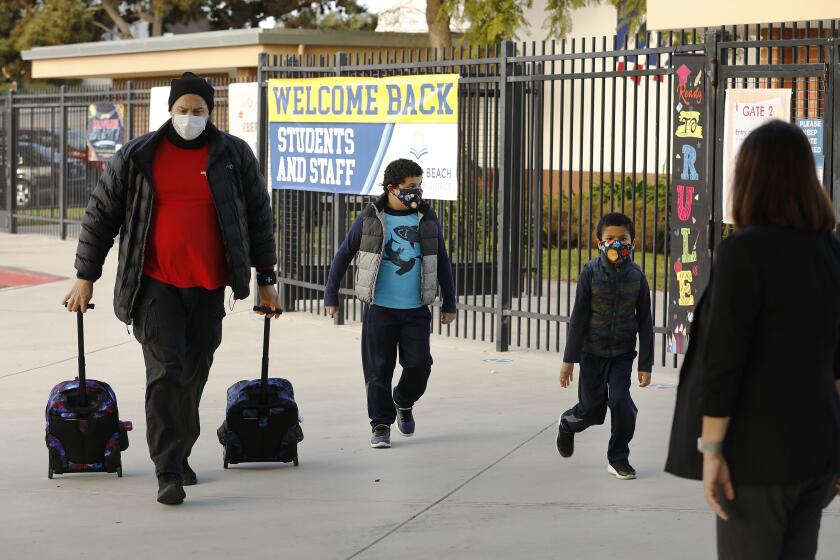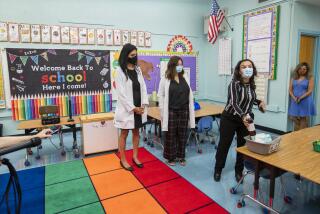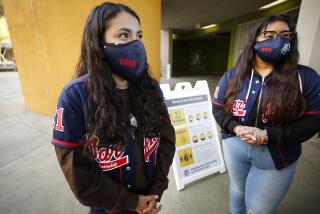New California law aims to put kids in class. Will it work?

California Gov. Gavin Newsom has signed a bill that will provide $6.6 billion in aid to state schools struggling to reopen during the pandemic.
- Share via
SACRAMENTO, Calif. — California’s public schools can tap into a $6.6-billion school reopening plan that Gov. Gavin Newson signed into law Friday, aimed at pressuring districts to reopen classrooms by the end of March. Educators, parents and lawmakers question whether it will work.
After nearly one year of distance learning for most of California’s K-12 students, parents across the state say they are frustrated and losing hope their children will see the inside of a classroom this year.
“Is this money going to be a motivator? I don’t know,” said Dan Lee, a father in San Francisco where the city sued its own school district to reopen classrooms. “We throw money at them, we sue them, we shame them. They still haven’t moved.”
The bill Newsom signed into law has attracted bipartisan support and scorn in equal measure, with both the governor and lawmakers saying Friday it marked an important step forward but was far from perfect.
The bill does not require school districts to resume in-person instruction. Instead, the state is dangling $2 billion before cash-strapped school boards, offering them a share of that money only if they start offering in-person instruction by the end of this month.
“This is the right time to safely reopen for in-person instruction,” said Newsom, who faces a likely recall election later this year, fueled by anger over his handling of the pandemic.
The legislation, which Gov. Gavin Newsom plans to sign on Friday, is the most far-reaching effort by legislators in more than six months to address the educational challenges brought on by the COVID-19 pandemic.
Newsom signed the bill via Zoom, unintentionally mimicking how most of the state’s 6.1 million public school students have been learning for the past year. The irony was not lost on Newsom, who said the virtual ceremony was necessary to include officials who were scattered across the state. He highlighted the struggles he and lawmakers had in negotiating the plan.
“When you look at 58 counties, a thousand-plus school districts, this truly is a challenge at a scale no other state in the country is faced with,” Newsom said.
Teachers from some of the state’s biggest districts have come out against the plan, saying schools can’t reopen until infection rates drop and enough educators have been vaccinated.
Among them is the powerful United Teachers of Los Angeles, whose members were voting Friday to reject what they called an unsafe return for the second-largest district in the nation. Earlier this week, the union slammed the reopening plan as “a recipe for propagating structural racism” by benefiting wealthier areas with lower infection rates.
“If you condition funding on the reopening of schools, that money will only go to white and wealthier and healthier school communities,” union leader Cecily Myart-Cruz said in a statement.
While California businesses have opened and closed through the ups and downs of the pandemic, many school boards have not been willing to return students to classrooms as they have struggled with the costs to implement public health standards and negotiations with teachers’ unions.
But as the rate of new coronavirus cases continues to fall and more people are getting vaccinated, politicians and parents have been pressuring districts to return to in-person learning before the end of the school year.
The new law is the state’s first attempt to do that on a statewide scale. Just as it doesn’t require school districts to return students to classrooms it does not force parents to send their kids back to schools if they don’t want to.
To be eligible for the money, most districts will have to offer in-person learning for all elementary school grades. But the law does not require a return to classrooms for most middle and high school students and does not mandate how long the students must be in classrooms.
That’s prompted fears that some districts could return students for just one day per week and still be eligible for the money.
OpenSchoolsCA, a parents’ group that has advocated for in-person schooling, called the legislation “another failed attempt” at reopening classrooms that won’t be enough to persuade many districts, especially in large, urban areas.
Parents like Liz Ingle, of San Diego, a mother of two elementary school children, are already fearful of what the fall will bring.
“We’re all feeling like if we don’t get all of our kids on campus before the end of the year, the chance that they’re going to open in hybrid in fall is more likely,” said Ingle.
She said the plan doesn’t make districts move any faster but leaves reopening up to them.
“We’ve already seen that when they have choices they don’t move very quickly,” said Ingle, who plans to join one of several rallies next weekend to mark the one-year anniversary since schools closed.
The new law also sets aside $4.6 billion in spending for all districts to help students catch up, 85% of which must be used for in-person learning.
“We’re going to go home to our districts and beg all of our [school] districts to open up,” said Assemblyman Phil Ting, a Democrat from San Francisco, where public schools have stayed closed all year despite one of the lowest COVID-19 rates in California.
The San Francisco school board drew national scorn earlier this year for focusing on renaming 44 schools it says honored racially insensitive figures, including Abraham Lincoln, rather than working to reopen classrooms. It has since paused the renaming project.
The foot-dragging in San Francisco has prompted many parents to switch to private schools, which are holding in-person classes, or move out of the city.
Melissa Nemer, a San Francisco mother of two, plans to move out of the city this summer. She has watched relatives in New York City, Denver, Colorado and Minnesota suburbs send kids back to school as hers remain stuck in distance learning.
“There are no dates for reopening, there is no timeline, there’s nothing,” said Nemer. “Enough is enough.”
More to Read
Sign up for Essential California
The most important California stories and recommendations in your inbox every morning.
You may occasionally receive promotional content from the Los Angeles Times.











